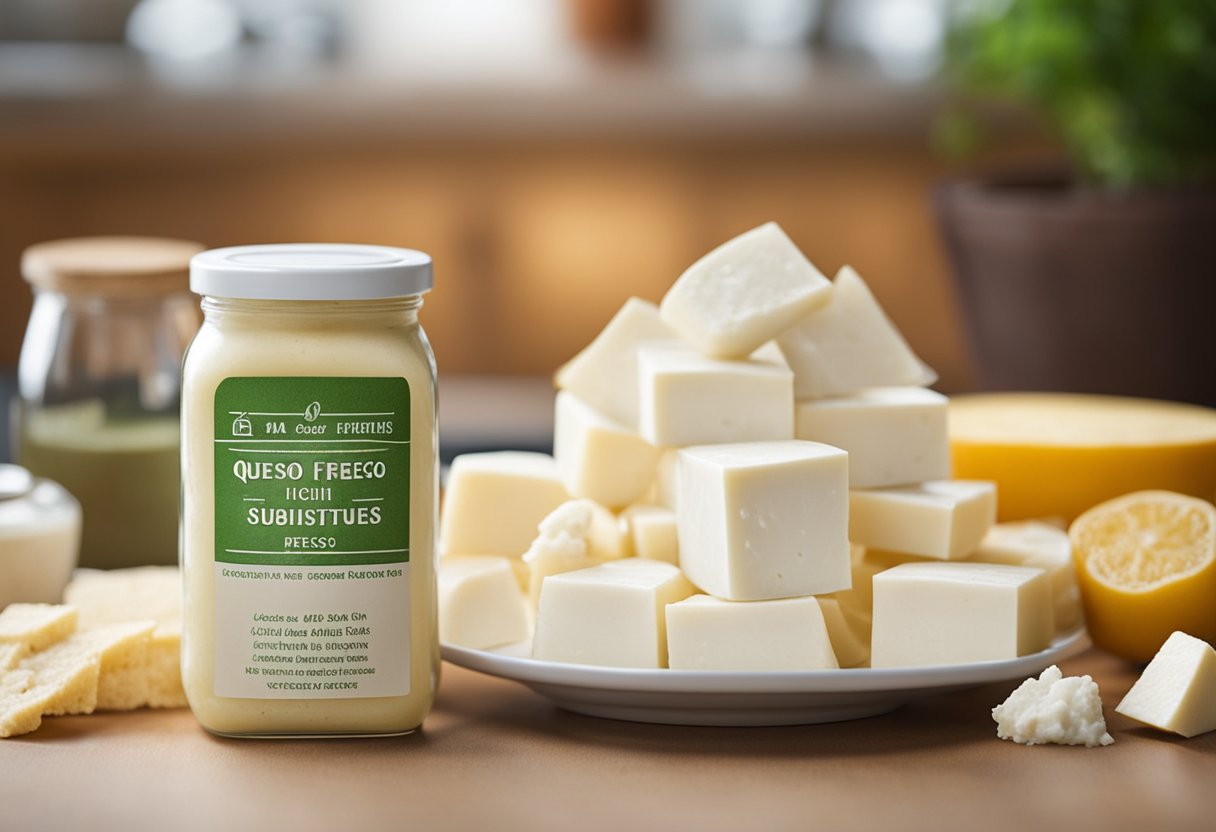If you’re a fan of Mexican cuisine, you’re probably familiar with queso fresco. This soft, crumbly cheese is a staple in many dishes, from tacos to enchiladas.
However, if you can’t find queso fresco at your local grocery store, or if you’re lactose intolerant or vegan, you might be wondering what you can use instead.
Fortunately, there are several substitutes for queso fresco that can work just as well in your favorite recipes.

When it comes to finding a queso fresco substitute, there are a few things to keep in mind. First and foremost, you’ll want to consider the texture and flavor of the cheese.
Queso fresco is soft and crumbly with a mild, slightly tangy flavor. Some substitutes, like feta cheese, have a similar texture and taste, while others, like tofu, have a completely different texture and flavor profile.
Additionally, you’ll want to consider whether the substitute is lactose-free or vegan if those are dietary restrictions you need to accommodate.
In this article, I’ll walk you through some of the best queso fresco substitutes, including both dairy and non-dairy options.
I’ll also provide tips on how to make your own queso fresco substitute at home, and I’ll compare the different substitutes so you can choose the one that’s right for your needs.
Whether you’re making tacos, enchiladas, or another Mexican dish, you’ll be able to find a queso fresco substitute that works for you.
Key Takeaways
- Queso fresco is a soft, crumbly cheese that’s commonly used in Mexican cuisine.
- There are several substitutes for queso fresco, including both dairy and non-dairy options.
- When choosing a queso fresco substitute, consider the texture, flavor, and any dietary restrictions you have.
Understanding Queso Fresco

As a Mexican cheese, Queso Fresco is a popular choice for many dishes due to its mild and tangy flavor, as well as its crumbly texture. It is made from a mixture of cow and goat milk, and is typically white in color.
One of the key features of Queso Fresco is its crumbly texture, which makes it an ideal topping for many dishes. It is often used in Mexican cuisine to top tacos, enchiladas, and other dishes.
While Queso Fresco is a popular cheese, it may not be readily available in some areas. In such cases, there are several substitutes that can be used in its place.
These substitutes range from other Mexican cheeses, such as Queso Blanco and Cotija, to other types of cheese, such as feta and paneer.
When selecting a substitute for Queso Fresco, it is important to consider the flavor and texture of the cheese. For example, Cotija cheese is a good substitute for Queso Fresco due to its similar crumbly texture and salty flavor.
Overall, Queso Fresco is a delicious and versatile cheese that can be used in a variety of dishes. However, when it is not available, there are several substitutes that can be used to achieve a similar flavor and texture.
The Importance of Texture and Flavor
As a cheese lover, I understand the importance of texture and flavor when it comes to choosing the right cheese.
Queso Fresco is a popular cheese in Mexican cuisine, known for its mild flavor, crumbly texture, and salty taste. However, it may not always be readily available, or you may want to explore other options.
When looking for a substitute for Queso Fresco, it is important to consider its texture. The cheese should be crumbly, but not too dry or hard.
Feta cheese is a great alternative, as it has a similar texture and creaminess. However, it can be tangy and salty, so it is important to rinse it with cold water to remove any excess saltiness.
Another factor to consider is the flavor of the cheese. Queso Fresco has a mild, milky taste, which makes it a versatile cheese that can be used in a variety of dishes.
If you want a similar flavor, try using Ricotta cheese, which has a similarly mild and creamy taste.
If you want a tangy and sour taste, consider using Goat cheese. It has a similar crumbly texture to Queso Fresco and a tangy flavor that can add a unique twist to your dishes.
In summary, when looking for a substitute for Queso Fresco, it is important to consider the texture and flavor of the cheese.
Feta cheese, Ricotta cheese, and Goat cheese are great alternatives that can add a unique twist to your dishes.
Common Queso Fresco Substitutes
When it comes to substituting Queso Fresco, there are several options to choose from. Here are some of the most commonly used alternatives:
Feta Cheese
Feta cheese is a popular substitute for Queso Fresco due to its crumbly texture, color, and creaminess.
However, it has a tangy taste compared to Queso Fresco, so it is recommended to rinse it with cold water to remove that salty and bold taste.
Paneer
Paneer is a fresh, unsalted cheese that is widely used in Indian cuisine. It has a similar texture to Queso Fresco and can be used as a substitute in many Mexican dishes.
Paneer is also a good source of protein and calcium.
Ricotta Salata
Ricotta Salata is a salted, aged version of ricotta cheese that has a crumbly texture and a slightly salty taste. It is a great substitute for Queso Fresco in salads, pasta dishes, and sandwiches.
Monterey Jack Cheese
Monterey Jack Cheese is a semi-hard cheese that has a mild, buttery flavor and a creamy texture. It is a good substitute for Queso Fresco in dishes like quesadillas, enchiladas, and tacos.
Cotija Cheese
Cotija Cheese is a hard, crumbly cheese that is often used in Mexican cuisine. It has a salty, tangy flavor and a texture similar to feta cheese.
Cotija Cheese is a good substitute for Queso Fresco in dishes like salads, tacos, and tostadas.
Tofu
Tofu is a versatile, plant-based protein that can be used as a substitute for Queso Fresco in many dishes.
Firm tofu or extra-firm tofu can be crumbled and used in place of Queso Fresco in salads, tacos, and burritos.
Cottage Cheese
Cottage Cheese is a fresh cheese that has a slightly tangy flavor and a creamy texture. It can be used as a substitute for Queso Fresco in dishes like salads, tacos, and tostadas.
Goat Cheese
Goat Cheese is a tangy, crumbly cheese that can be used as a substitute for Queso Fresco in many Mexican dishes. It has a distinct flavor that pairs well with spicy foods.
Farmer Cheese
Farmer Cheese is a fresh cheese that has a mild flavor and a crumbly texture. It can be used as a substitute for Queso Fresco in dishes like salads, tacos, and tostadas.
Quark
Quark is a fresh cheese that is similar in texture to cream cheese. It has a mild flavor and can be used as a substitute for Queso Fresco in many dishes. Quark is also a good source of protein and calcium.
Overall, there are many alternatives to Queso Fresco that can be used in various dishes. It’s important to choose a substitute that has a similar texture and flavor to ensure the best results.
Queso Fresco in Mexican Cuisine
As a staple in Mexican cuisine, queso fresco is a versatile cheese that can be used in a wide variety of dishes.
Its mild flavor and crumbly texture make it a popular choice for salads, soups, enchiladas, tacos, fajitas, quesadillas, empanadas, nachos, and more.
One of the most common ways to use queso fresco is to sprinkle it on top of salads. Its light and milky taste pairs well with fresh greens and vegetables.
It can also be crumbled on top of soups for added texture and flavor.
In Mexican dishes such as enchiladas and tacos, queso fresco can be used as a filling or topping.
Its crumbly texture makes it easy to mix with other ingredients, and its mild flavor won’t overpower the other flavors in the dish.
For fajitas and quesadillas, queso fresco can be melted and used as a filling. Its mild flavor and creamy texture make it a great substitute for other cheeses such as cheddar or mozzarella.
In Mexican grocers, queso fresco can be found in various forms such as blocks, crumbles, or rounds. It is often made from cow’s milk but can also be made from goat’s milk or a combination of both.
Overall, queso fresco is a versatile and delicious cheese that can be used in a wide variety of Mexican dishes.
Its mild flavor and crumbly texture make it a popular choice for salads, soups, enchiladas, tacos, fajitas, quesadillas, empanadas, nachos, and more.
Vegan and Lactose-Intolerant Friendly Substitutes
As a lactose-intolerant person myself, I understand the struggle of finding suitable cheese substitutes.
Luckily, there are several vegan and lactose-free options available for those who cannot consume dairy products.
One popular substitute for queso fresco is tofu. Tofu is a versatile ingredient that can mimic the texture and flavor of queso fresco when seasoned properly. It is also a great source of protein and is low in fat.
Another option is nutritional yeast, which has a cheesy, nutty flavor and can be used as a topping or ingredient in various dishes.
It is also a good source of vitamin B12, which is important for vegans who may not get enough of this nutrient from their diet.
For those who prefer a soy-based option, soy cheese is a great alternative. It has a similar texture and flavor to queso fresco and is available in many grocery stores.
However, it is important to note that some people may be allergic to soy and should avoid this option.
Lastly, there are several dairy-free cheese brands that make queso fresco alternatives.
These cheeses are made from plant-based ingredients such as nuts, seeds, and coconut oil, and are often fortified with vitamins and minerals. Some popular brands include Daiya, Violife, and Follow Your Heart.
Overall, there are several vegan and lactose-free substitutes for queso fresco that can be used in a variety of dishes.
It is important to experiment with different options to find the one that best suits your taste and dietary needs.
Making Your Own Queso Fresco Substitute

If you can’t find queso fresco at your local grocery store, don’t worry. You can easily make your own substitute at home using simple ingredients.
To make a homemade queso fresco substitute, you will need cow’s milk or goat’s milk, vinegar or lemon juice, and a strainer or cheesecloth.
First, heat half a gallon of milk in a large pot on medium heat. Once the milk reaches a temperature of 170°F, take it off the heat and add 2/3 of a cup of vinegar or lemon juice. Stir the mixture a few times and let it sit for about 45 minutes.
After 45 minutes, the milk should have curdled. Place a strainer or cheesecloth over a large bowl and pour the curdled mixture into it. The whey will drain into the bowl, leaving the curd behind.
Once the whey has drained off, you can add salt to taste and press the curd into a mold or shape it by hand. Let it sit for a few hours to firm up before using it in your favorite recipes.
Note that the taste and texture of your homemade queso fresco substitute may vary depending on the type of milk and acid you use.
Cow’s milk will produce a milder flavor, while goat’s milk will have a tangier taste. You can also experiment with different acids, such as vinegar or lemon juice, to find the flavor you prefer.
Overall, making your own queso fresco substitute is a simple and cost-effective way to enjoy this popular cheese. Give it a try and see how easy it is to make at home!
Comparing Queso Fresco Substitutes
As a cheese lover, I know that finding the perfect substitute for Queso Fresco can be a daunting task. But don’t worry, I have done the research for you, and here’s what I found.
When comparing Queso Fresco substitutes, one of the main differences you’ll notice is the flavor. Some substitutes, like Feta cheese, have a tangy taste compared to Queso Fresco.
Others, like Ricotta cheese, have a more mild and sweet flavor. It’s important to keep in mind the flavor profile of your dish when selecting a substitute.
Another factor to consider is the texture of the cheese. Queso Fresco has a semi-soft texture, which makes it perfect for crumbling on top of dishes or melting into sauces.
Some substitutes, like Paneer, have a similar soft texture, while others, like Cotija cheese, are harder and crumbly.
If you’re looking for a substitute that has a salty flavor similar to Queso Fresco, then Feta cheese or Cotija cheese might be a good option.
However, if you want a milder taste, then Ricotta cheese or Farmer’s cheese might be a better choice.
It’s also important to note that some substitutes, like Danish Feta or French Feta, may have a bolder taste than traditional Queso Fresco.
If you’re not a fan of spicy or bold flavors, then you may want to avoid these substitutes.
Finally, if you’re looking for a vegan or dairy-free option, then Tofu can be a great substitute for Queso Fresco. It has a similar texture and can be seasoned to mimic the flavor of Queso Fresco.
In summary, when comparing Queso Fresco substitutes, it’s important to consider the flavor, texture, and type of dish you’re making.
With so many options available, you’re sure to find the perfect substitute for your next recipe.
Other Uses of Queso Fresco Substitutes

As I mentioned earlier, queso fresco substitutes can be used in a variety of dishes. In addition to using them as a topping for Mexican dishes, they can be used in other cuisines as well. Here are a few examples:
- Curries: Queso fresco substitutes like paneer and ricotta salata can be used in Indian curries instead of paneer. They have a similar texture and mild flavor that works well in curries.
- Sauces: Feta cheese can be used in place of queso fresco in sauces like tzatziki and Greek salad dressing. It adds a tangy flavor and creamy texture to the sauce.
- Crumble: Feta cheese and paneer can be crumbled over salads, roasted vegetables, and pasta dishes for added flavor and texture.
- Slice: Queso blanco and paneer can be sliced and used in sandwiches and wraps instead of queso fresco. They have a similar texture and mild flavor that works well in these dishes.
- Fry: Paneer can be fried and used in dishes like Indian pakoras and Chinese stir-fry dishes. It has a firm texture that holds up well when fried.
Overall, queso fresco substitutes can be used in a variety of dishes to add flavor and texture. Experiment with different substitutes to find the ones that work best for you and your favorite dishes.
Frequently Asked Questions

What are some substitutes for queso fresco in Mexican cuisine?
There are several substitutes for queso fresco in Mexican cuisine. Some of the best substitutes include feta cheese, ricotta salata, queso blanco, paneer, and monetary jack cheese.
These cheeses have a similar texture and taste to queso fresco, and can be used in a variety of Mexican dishes.
Can feta be used as a substitute for queso fresco?
Yes, feta cheese can be used as a substitute for queso fresco. Feta cheese has a crumbly texture, similar to queso fresco, and a mild, tangy taste.
However, it is important to rinse feta cheese with cold water to remove the salty taste before using it as a substitute for queso fresco.
What is a good substitute for Peruvian queso fresco?
If you are looking for a substitute for Peruvian queso fresco, you can try using feta cheese, ricotta salata, or queso blanco.
These cheeses have a similar texture and taste to Peruvian queso fresco, and can be used in a variety of Peruvian dishes.
What cheese is similar to queso fresco?
Several cheeses are similar to queso fresco, including feta cheese, ricotta salata, queso blanco, paneer, and monetary jack cheese.
These cheeses have a similar texture and taste to queso fresco, and can be used in a variety of dishes.
What is the difference between queso fresco and feta?
The main difference between queso fresco and feta cheese is the taste. Queso fresco has a mild, creamy taste, while feta cheese has a tangy, salty taste.
Additionally, feta cheese is brined and aged, while queso fresco is made from fresh milk.
Where can I buy queso blanco as a substitute for queso fresco?
You can buy queso blanco at most grocery stores or online. Some popular brands of queso blanco include Cacique, V&V Supremo, and El Mexicano.
Queso blanco has a similar texture and taste to queso fresco, and can be used as a substitute in a variety of dishes.







